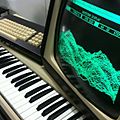Electronic music facts for kids
Electronic music is music which is made with electronic equipment such as synthesizers or computers. Sometimes electronic music artists create special sounds using tape recorders too.
After World War II, when tape recorders had been invented and were becoming popular, composers started to use them to make music. The tape recorder was needed for the performance. Composers used them to combine lots of different sounds. Sometimes it was music played on ordinary (acoustic) instruments which was then changed in some way by the tape recorder. Sometimes they took sounds from everyday life such as the sound of water, traffic noise or bird song. All these noises were put together in the way the composer wanted by using the tape recorder. Tapes of sounds were often cut into pieces, then the pieces were 'spliced' – put back together in a different order. The results were often very interesting, but there were problems. Some people asked: “Is it music?” Others thought it was boring to just look at a tape recorder during a concert instead of being able to watch live musicians play.
Composers in Paris were experimenting with electronic music in the 1940s. They called it “Musique concrète” because they used natural, concrete sounds. (“Concrete” in this sense meant the opposite of “abstract” music which was written down for performance). The sounds were played back at different speeds, combined in lots of ways, played backwards or played continuously (repeated in a 'loop'), or played into a mixer and re-recorded onto another tape recorder. The sounds could be filtered. Effects such as vibrato or echo could be added. Sometimes composers used synthesizers which were machines that could make electronic music in real time. They sounded more like normal instruments than the sound effects on a tape recorder.
Computers have often been used for composing electronic music.
Classical music
Composers who have used these ways of making music include John Cage (1912-1992), Bruno Maderna (1920-1973) and Karlheinz Stockhausen (b.1928). Very often composers combined electronic music with ordinary instruments being played.
Popular music
In popular music, the use of electronics to create new sounds began in the 1960s. Producer Joe Meek and inventor Bob Moog both expanded the range of sounds that could be used in pop music, and by the end of that decade electronics had become accepted in the industry. In the next few years the work of people like Giorgio Moroder, Jean-Michel Jarre, Brian Eno and Kraftwerk made electronic music famous.
In the early 1980s electronic music became fashionable, and bands like New Order, The Human League, Pet Shop Boys and Depeche Mode became famous. Sometimes these bands would mix electronic music with rock music.
In the 21st Century electronics are so much a part of popular music that using it is no longer strange - in fact, many artists use nothing else.
Dance music
A subgenre of electronic music is electronic dance music, or EDM. Electronic dance music is a form of electronica which is generally made with the intention of being danced to, thus making it generally club-friendly and often (but not always) up-tempo in nature. Whilst a lot of electronic genres are also classified as EDM, not all forms of electronic music fall within the specific category. Examples of EDM genres include post-disco, house, techno, Eurodance, trance, trip hop, drum and bass and dubstep, as well as several others.
In 2018, Billboard released a market statistic that proved the value and worth of the electronic dance music market. In this statistical statement, the company shows a 12-percent growth within one year where many changes took place with this musical revolution. One of the biggest helpers in this EDM market growth was YouTube.
New Grove Dictionary of Music and Musicians 1980; ISBN 1-56159-174-2
Images for kids
-
Front page of Scientific American in 1907, demonstrating the size, operation, and popularity of the Telharmonium
-
Leon Theremin demonstrating the theremin in 1927
-
CSIRAC, Australia's first digital computer, displayed at the Melbourne Museum
-
Israeli composer Josef Tal at the Electronic Music Studio in Jerusalem (c. 1965) with Hugh Le Caine's Creative Tape Recorder (a sound synthesizer) aka "Multi-track"
-
Early electronic organ: Yamaha Electone D-1 (1959)
-
Early drum machine: Korg Donca Matic DA-20 (1963)
-
Keith Emerson performing in Saint Petersburg in 2008
-
Yamaha DX7, a model for many digital synthesizers of the 1980s
See also
 In Spanish: Música electrónica para niños
In Spanish: Música electrónica para niños

















